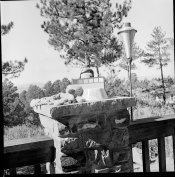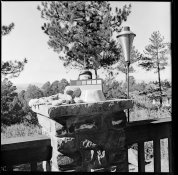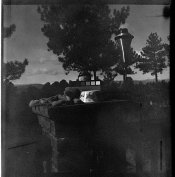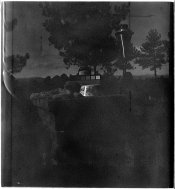I recently bought some pyro developer (liquid PMK) for some experiments since I've read a lot of people saying it's a unique developer etc etc. I had also heard it can be low contrast so it seemed to match up with my current experiment of getting ortho litho film to have a reasonable amount of contrast. At this it excels (though I have to use 1:1:100, not 1:2:100).
Anyway, I'm curious of a few things:
* Pushing film, is it at all reasonable?
* I've heard of pyro being used as paper developer. Is that possible with PMK? What is the benefit?
* On massive dev chart, most of the films are like HP5+ 280-400 ISO and such. Should I downgrade the speed of the film I intend to process in this for best results?
* What effects can be had by using different dilutions? I know part B (the base) apparently controls contrast to an extent, but beyond that?
* How do you clean trays afterwards that are stained by pyro? Will the stain harm any future solutions put into the tray?
* Is there any alternative to TF-4 for an alkaline fixer (acid fixers strip the stain) that is less smelly?
* Does the workflow formulary recommends really help? They recommend develop -> water stop -> alkaline fix -> soak in (used) developer -> 20m water bath to maximize stain
Bob's answer above is right on. I'll answer as well though, just to give you my experience and ideas (which vary from Bob's on a few small points).
First, "pushing" film is just underexposing (i.e., losing shadow detail and exposing highlights where the mid-tones should be) and then overdeveloping to increase overall contrast enough to get some kind of printable image (or the "look" if that's what you're after). There are better developers for this than PMK. As for expansions, (i.e., developing a negative to a higher than normal contrast to compensate for low contrast in the scene), PMK works fine to a certain extent. I get a pretty good N+1 from a number of films with PMK at normal dilutions, albeit with a bit of added base fog, which I compensate for at the time of exposure by giving 1/3-stop more exposure. For greater expansions I've taken to using PMK 1:3:100 or even adding ascorbic acid to the developer (which seems to work well, but I'm still dialing it in).
As Bob noted, PMK oxidizes quickly, so it doesn't really lend itself to developing paper. If you were to develop paper in it, it would a) need to be a lot stronger and b) have the overall greenish stain, which may not be be the most aesthetically pleasing... There was a thread about developing prints in PMK here or over at the LF forum - Google is your friend...
You should determine your personal E.I. with PMK yourself. The goal is to give just enough exposure to get the shadow detail you want plus a, say 1/3-stop, safety margin. Many just halve the ISO and start there, which works well for large-format negatives where grain isn't such an issue and a bit of overexposure can be tolerated. However, if you are using smaller film and want to minimize grain (PMK is not the finest-grain developer), you may want to rate the film higher and see if the shadow detail is adequate for you. FWIW I rate TXP320 and TMY400 both at E.I. 250 with PMK; that's 1/3 and 2/3-stop slower than box speed respectively. Your results will vary.
Unlike Bob, I clean my trays after each developing session. The PMK stain seems to come off just fine with normal dishwashing detergent and a scrubber sponge (not the too-scratchy green Scotch-Brite pads, but the non-scratch variety). A bit of chlorine bleach gets the stubborn stains. Now my darkroom sink... that's another matter. I try to keep it clean, but it invariably gets brown stains. I repaint occasionally.
About fixers: Acid fixers will not strip the stain from PMK negatives, at least not the mildly acid rapid fixers that are commonly on the market. It will make them a bit harder to wash, however. Like Bob, I've been using Ilford Hypam (without the hardener) or Rapid Fixer with fine results for years. Kodak Rapid Fix and the Tetenal rapid fixer work just fine too. What will strip the stain from PMK negs is the wash aid (Hypo Clearing Agent or the like, so don't use any of these products on stained negatives. With PMK and Ilford Rapid Fixer I have standardized on a 30-minute wash. 20 minutes may be just fine for you, but you really need to test to find out for sure. Search for tests on residual hypo (Kodak HT-2) and read the sticky thread on film washing in the B&W film and paper forum here.
As for the spent-developer after-bath: At some point, PMK's formulator, Gordon Hutchings, changed his recommendation and said the post-fixer bath in used developer was no longer necessary. I've developed both ways and prefer the negatives without the used developer bath. They seem to have just as much image stain and slightly less overall base stain. Really, though, there's not much difference at all between the two methods. FWIW, I do use a weak sodium carbonate bath for TMY negatives just before they go into the wash. This is to remove the stubborn blue/magenta dye that I just can't seem to get out any other way (extended fixing and/or washing doesn't do the trick, but a minute in the carbonate nixes the dyes well). This seems to have no effect, one way or the other, on the PMK stain.
Unlike Bob, I have no problems with extended development (up to 20 minutes) in PMK as long as I process in small batches and begin processing as soon as I've mixed the developer working solution. I usually tray-develop 6 sheets of 4x5 in 500ml of developer (occasionally 8 sheets in 750ml). I mix the developer, turn out the lights, unload the holders and soak in water for three minutes prior to development. That means the developer sits for about five minutes before development begins. No problems for me. I think Bob uses rotary development if I'm not mistaken, which will oxidize the developer much faster than the tray development I use.
I use distilled water to mix the stock solutions, but regular Eugene, Oregon tap water for the working solution. I've had no problems in that regard. You'll have to test with your tap water to see if it causes problems or not.
Best,
Doremus











